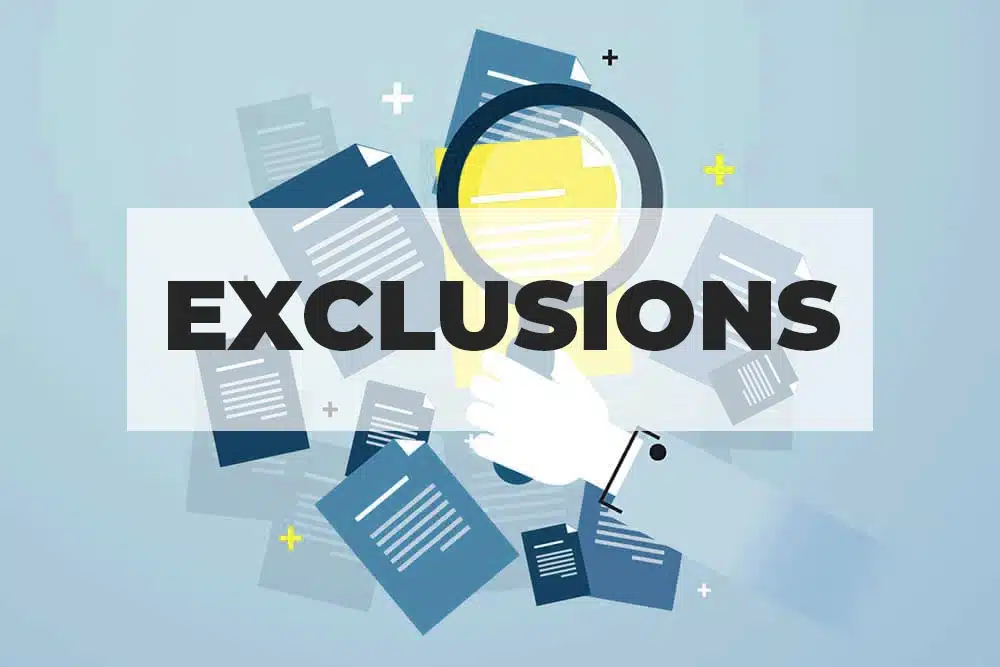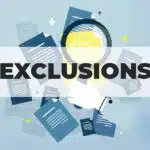When you buy an insurance policy, you think it will cover many risks. But, there are exclusions – things the insurer won’t cover. It’s important to know about these exclusions because they can leave you open to financial risks.
Exclusions help balance what the insurer needs to stay strong and what you want in protection. By not covering some risks, insurers can charge lower premiums. Knowing about these exclusions can help you see where your coverage might be weak. This lets you take steps to fill those gaps.
Key Takeaways
- Policy exclusions are events or situations that an insurance policy will not cover.
- Exclusions help insurers maintain solvency and offer more affordable premiums.
- Understanding common exclusions, such as catastrophic events, intentional actions, and maintenance issues, can help you identify coverage gaps.
- Reviewing your policy carefully and considering additional coverage options can ensure you have the protection you need.
- Consulting with insurance professionals can help you navigate the complexities of policy exclusions and find the right coverage for your needs.
Understanding Insurance Policy Exclusions
Insurance policies aim to cover unexpected losses. But, they also have exclusions. These are the risks and events not covered by the policy. It’s important for policyholders to know these exclusions. They affect coverage and the ability to make claims.
What Are Insurance Exclusions?
Insurance exclusions are parts of policies that don’t cover certain risks or events. Insurers use them to balance coverage with their ability to pay claims. This helps them stay solvent and keeps the insurance system working well.
Common Types of Exclusions
Insurance policies have many exclusions, and they vary by policy type and coverage. Here are some common ones:
- Catastrophic events like earthquakes, floods, and nuclear accidents
- Intentional actions and illegal activities by the policyholder
- Risks covered elsewhere, like by other insurance or government programs
- Maintenance issues and wear and tear
- Easily controllable risks that the policyholder could have prevented
Knowing these exclusions helps policyholders see coverage gaps. This way, they can make better insurance choices.
Also Read : Taxation Strategies For Financial Planning
| Exclusion Type | Description | Example |
|---|---|---|
| Catastrophic Events | Exclusions for large-scale, uncontrollable natural disasters | Earthquake, flood, hurricane, nuclear accident |
| Intentional Actions and Illegal Activities | Exclusions for damages or criminal behavior caused on purpose | Arson, vandalism, theft |
| Risks Covered Elsewhere | Exclusions for losses covered by other policies or programs | Auto insurance, workers’ compensation, social security |
| Maintenance and Wear and Tear | Exclusions for damages from not maintaining things or normal wear | Roof leaks, plumbing issues, electrical problems |
| Easily Controllable Risks | Exclusions for losses that could have been prevented by the policyholder | Failure to secure property, neglect of safety precautions |
Catastrophic Exclusions
Insurance policies often face challenges from catastrophic risks. These risks can affect many people at once, making it hard for insurers to pay claims. That’s why many policies don’t cover things like war or unexpected natural disasters like floods and tornadoes. These exclusions are called “catastrophic” or “war exclusions.”
You usually can’t get war coverage with a standard policy. But, you might buy a separate policy for natural disasters. These policies help protect you from the financial hit of severe weather, earthquakes, and other big events.
| Catastrophic Risk | Typical Exclusions | Separate Coverage Options |
|---|---|---|
| War | Most standard insurance policies exclude coverage for damages or losses caused by war, civil war, invasion, or other hostile acts. | Standalone war insurance policies are available, but they are often expensive and have limited coverage. |
| Natural Disasters | Floods, earthquakes, tornadoes, and other natural disasters are commonly excluded from standard insurance policies. | Catastrophic insurance policies can provide coverage for these types of natural disasters, often with higher limits and specialized coverage options. |
It’s key to look at your insurance policy’s exclusions. This way, you know what risks aren’t covered. With this knowledge, you can decide if you need more coverage or how to protect yourself from these big risks.
Also Read : What Is Finance Services And How To Work?
Intentional Actions and Illegal Activities
Insurance coverage often doesn’t cover intentional acts and damages. Most policies say they won’t pay for losses from criminal behavior or illegal actions. If someone causes harm on purpose or breaks the law, their insurance won’t help pay for it.
Intentional Acts and Deliberate Damages
For example, if someone gets angry and crashes into another car on purpose, their car insurance won’t cover it. If a contractor destroys a client’s property over a money issue, the insurance won’t pay for it either.
Criminal Behavior and Unlawful Conduct
Insurance also doesn’t cover criminal acts and illegal actions. If someone steals or vandalizes property and causes damage, their insurance won’t help. These actions go against what insurance is meant for, which is to protect against accidents and things we can’t control.
It’s important for people and businesses to know about these exclusions. This way, they won’t be surprised when they try to make a claim. Knowing about intentional damage and criminal actions helps them plan better and avoid risks.
“Insurance is designed to protect against unintentional and accidental losses, not to cover the consequences of intentional, deliberate, or criminal actions.”
Also Read : How To Maintain Skin Hydration Throughout The Day?
Risks Covered Elsewhere
Understanding insurance can be tough, especially when looking at policy exclusions. Many risks not covered in one policy are in another. For instance, a general liability policy won’t cover car accidents, which is for a commercial auto policy.
Knowing which risks each policy covers helps avoid buying too much insurance. This is where overlapping coverage comes in. By knowing about separate insurance policies that cover certain liability coverage exclusions, people and businesses can make their insurance better. They can avoid gaps in protection.
Looking closely at policy details and comparing them helps find where coverage overlaps or is missing. This lets policyholders make smart choices. They can make sure they’re not paying for the same thing twice or missing coverage they need.
Getting the hang of insurance policy exclusions and how different policies work together is key to full protection. By staying informed and working with insurance experts, policyholders can handle insurance with ease. They can rest easy knowing they’re well-protected.
Also Read : What Are The Different Types Of Loans?
Policy Exclusions
Where to Find Exclusions in Your Policy
Understanding your insurance coverage means knowing about policy exclusions. These are the specific situations or events not covered by your policy. You’ll usually find them after the coverage section or within each coverage description.
It’s key to read your policy carefully to spot these exclusions. This way, you’ll know what’s not covered and can plan for any gaps. You might need more insurance or endorsements to fill these gaps.
If you’re not sure about exclusions or coverage limits, talk to your insurance provider. They can explain your policy and help you make sure you’re well-protected.
| Key Takeaways |
|---|
|
Knowing where to find exclusions in your policy helps protect you and your assets. It lets you make smart choices about your insurance. This ensures you have the right coverage for your needs.
Also Read : What Clauses Should Be Included In A Loan Agreement?
Maintenance and Wear and Tear
Not every risk can be covered by insurance. Many policies don’t cover damage from wear-and-tear or lack of maintenance. These uncontrollable losses are often seen as the owner’s responsibility. They can be prevented with good care and upkeep of the insured item.
Insurance companies don’t cover maintenance exclusions because they’re part of owning a home, vehicle, or property. Even with the best care, some parts will wear out or break over time. This is seen as an insurable risk that owners should plan for with regular maintenance and repairs.
| Maintenance-Related Exclusions | Examples |
|---|---|
| Wear and tear | Fading paint, cracked leather, worn tires, leaky faucets |
| Lack of maintenance | Clogged gutters, neglected HVAC systems, unmaintained roofs |
| Corrosion and rust | Oxidation on metal surfaces, deteriorating concrete foundations |
Knowing what insurance doesn’t cover helps policyholders prepare for and manage these uncontrollable losses. They can keep their assets safe and count on their insurance for unexpected, insurable risks.
Controllable Risks and Precautions
As a policyholder, knowing what risks your insurance doesn’t cover is key. These are risks you can prevent or lessen with careful actions. By being proactive, you can make sure you’re well-protected against these risks.
Mitigating Excluded Risks
One risk that’s often not covered is snow on your roof. If snow makes your roof collapse, your insurer might say you could have prevented it by removing the snow. They might also not cover water damage if you didn’t keep up with home maintenance, like cleaning gutters or fixing leaks.
To avoid these risks, it’s important to keep up with your home’s upkeep. This means checking your property for dangers and fixing them quickly. Here are some steps you can take:
- Clear snow and ice from your roof, gutters, and other areas at risk
- Fix leaks or moisture problems right away
- Keep important systems like the HVAC and plumbing in good shape
- Make sure your home is well-ventilated and insulated to prevent water damage
By doing these things, you show you’re trying to prevent risks. This might help you avoid having your insurance claim denied because of exclusions.
Knowing what your insurance doesn’t cover and taking steps to prevent risks is crucial. It helps protect your assets and ensures you’re covered if something unexpected happens.
Endorsements and Additional Coverage
As an insurance policyholder, you might find exclusions in your policy that leave you open to certain risks. Luckily, there are ways to cover these gaps. You can get extra insurance policies or add endorsements to your current policy.
Getting a separate policy can cover risks your main policy doesn’t. For instance, if your homeowner’s policy doesn’t cover data breaches, consider a cyber liability policy. Or, you can add endorsements to your policy. These are add-ons that can change or increase your coverage.
Endorsements are a smart way to customize your insurance policy and fill in gaps. They can cover things like floods, earthquakes, or increase coverage for valuable items. An insurance expert can help you find the right additional insurance coverage and policy endorsements for your needs.
| Addressing Exclusions | Additional Insurance Policy | Policy Endorsement |
|---|---|---|
| Cyber Liability | ✓ | – |
| Flood Coverage | ✓ | ✓ |
| Earthquake Protection | ✓ | ✓ |
| Increased Limits for Valuables | – | ✓ |
Knowing your options to customize your insurance policy and fill coverage gaps gives you peace of mind. Talking to an insurance expert is the best way to find the policy endorsements and additional insurance coverage you need.
Consulting Insurance Professionals
Understanding your insurance policy can be tough. That’s why it’s key to work with experts in insurance. These policies are complex legal documents. They have many details about coverage, exclusions, and endorsements.
Experts can give you insights to help you make smart choices about your insurance. They can review your policy and spot coverage gaps. This means they look at what you have and see where you might not be fully protected.
They focus on coverage gap analysis. This is crucial for understanding what your policy doesn’t cover. It ensures you have the right protection.
Working with insurance experts also lets you look into extra coverage or endorsements. They explain exclusions and help you find the best way to fill coverage gaps.
With the help of insurance pros, you’ll understand your policy better. You’ll make informed choices about your coverage. And you’ll feel secure knowing you’re well-protected.
“Consulting with a knowledgeable insurance professional can help you make informed decisions and ensure you have the right protection in place.”
Also Read : How To Choose & Apply Medical Insurance
Conclusion
It’s key to know about insurance policy exclusions to protect your business or personal stuff. Learning about exclusions for big events, intentional actions, and other issues helps spot coverage gaps. This lets you fix these gaps.
Talking to an insurance expert can also help. They can explain exclusions and help you add more coverage or special parts to your policy. Understanding your policy exclusions, insurance coverage, and risk management strategies is important. It helps you avoid unexpected costs and get the protection you need.
By doing a full policy review and getting help from skilled insurance professionals, you can handle your policy’s complex parts. This way, you can make smart choices to protect your assets and reduce risks.
FAQs
Q: What are policy exclusions in insurance?
A: Policy exclusions are specific situations, conditions, or events that are not covered by your insurance policy general liability insurance policies. They are typically listed in your policy and outline what your insurance company will not pay for.
Q: Why do policy exclusions matter in your insurance?
A: Policy exclusions are important because they can impact the coverage you have and the situations in which you will not be protected. Understanding these exclusions will help you know what risks are not covered and what additional coverage you may need.
Q: What are common exclusions in homeowners insurance?
A: Common exclusions in homeowners insurance include damage from floods, earthquakes, and certain types of water leakage. It is important to review your policy to understand what specific exclusions may apply to your coverage.
Q: How do insurance companies determine policy exclusions?
A: Insurance companies determine policy exclusions based on the level of risk they are willing to cover and the types of events they consider too costly or unpredictable to insure against peril. These exclusions are outlined in your insurance contract liability insurance.
Q: Can policy exclusions be negotiated or removed?
A: Policy exclusions are typically non-negotiable, as they are set by the insurance company to limit their liability and manage risks flood insurance. However, you can discuss options with your licensed insurance agent or broker to see if additional coverage can be purchased to address specific exclusions homeowners insurance policy.
Q: What should I do if I have concerns about policy exclusions in my insurance?
A: If you have concerns about the exclusions in your insurance policy, you should reach out to your insurance company or agent to discuss your questions or clarify any uncertainties. It’s important to review your policy carefully and understand what is and isn’t covered.
Q: How can I ensure I have the coverage I need despite policy exclusions?
A: To ensure you have adequate coverage despite policy exclusions, review your insurance policies regularly and consider purchasing additional coverage or separate policies for specific risks that are excluded from your primary insurance coverage.



)






